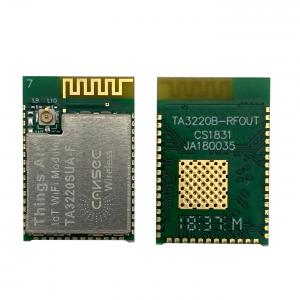Product Details
Cansec Ipv4 & Ipv6 TA3220SSA-F Ti CC3220 Transparent AT Command Rf
Wireless Transmitter And Receiver Module Wifi Module
Parameter | Min | Typ | Max | Unit |
Current
Consumption | Sleep Mode(For Hibernate) | - | - | 9 | uA |
| Transmit Mode (@18dbm,for carrier) | - | 400 | 450 | mA |
TX Power (For Carrier) | - | 17 | 20 | dBm |
RX Sensitivity | - | - | -96 | dBm |
Distance | 190 | m |
Cansec Ipv4 & Ipv6 TA3220SSA-F Ti CC3220 Transparent AT Command Rf
Wireless Transmitter And Receiver Module Wifi Module
1. TA3220S Module is designed based on TI’s CC3220S which is part of
the SimpleLink™ microcontroller (MCU) platform, which share a
common, easy-to-use development environment with a single core
software development kit (SDK) and rich tool set. A one-time integration of the SimpleLink platform enables you to
add any combination of the portfolio’s devices into your design,
allowing 100 per cent code reuse when your design requirements
change. For more information, visit Overview for SimpleLink™
solutions.
2. Start your Internet-of-Things (IoT) design with a Wi-Fi® CERTIFIED®
single-chip MCU System-on-Chip(SoC) with built-in Wi-Fi
connectivity. Created for the IoT, the SimpleLink™ CC3220x device
family from Texas Instruments™ is a single-chip solution,
integrating two physically separated, on-chip MCUs. • An application processor – ARM®
Cortex®-M4 MCU with a user-dedicated 256KB of RAM, and an optional
1MB of XIP flash. • A network processor MCU to run all Wi-Fi and
Internet logical layers. This ROM-based subsystem includes an
802.11b/g/n radio, baseband, and MAC with a powerful crypto engine
for fast, secure internet connections with 256-bit encryption.
3. The CC3220x wireless MCU family is part of the second generation of
TI’s Internet-on-a-chip™ family of solutions. This generation
introduces new features and capabilities that further simplify the
connectivity of things to the Internet. The new capabilities
including the following:
• Enhanced Wi-Fi provisioning • Enhanced power consumption
• Enhanced file system security (supported only by the CC3220S and
CC3220SF devices) Wi-Fi AP connection with up to four stations • More concurrently opened BSD sockets; up to 16 BSD sockets, of
which 6 are secure
• HTTPS support
• RESTful API support
• Asymmetric keys crypto library
• The CC3220x wireless MCU family supports the following modes:
station, AP, and Wi-Fi Direct®. The device also supports WPA2
personal and enterprise security. This subsystem includes embedded
TCP/IP and TLS/SSL stacks, HTTP server, and multiple Internet
protocols. The device supports a variety of Wi-Fi provisioning
methods including HTTP based on AP mode, SmartConfig™ Technology,
and WPS2.0.
• The power-management subsystem includes integrated DC-DC
converters that support a wide range of supply voltages. This
subsystem enables low-power consumption modes for extended battery
life, such as low-power deep sleep, hibernate with RTC (consuming
only 4.5 μA), and shutdown mode (consuming only 1 μA).
• The device includes a wide variety of peripherals, including a
fast parallel camera interface, I2S, SD, UART, SPI, I2C, and
4-channel ADC.
FAQ
Q1: Are you a factory or trade company?
A1: We are a professional factory with 25 years experience.
Q2: Can you accept OEM/ODM?
A2: Sure, we have rich OEM&ODM experience.
Q3: Do you have quality assurance?
A3; Each of our products has undergone quality testing and has two
years of free after-sales service.
What Is WiFi and What Does WiFi Stand for?WiFi stands for Wireless
Fidelity. This term was coined by a branding company, and it only
caught on in its abbreviated form. It describes a technology for
radio wireless local area networking of devices based on the IEEE
802.11 standards, which are maintained by the Institute of
Electrical and Electronics Engineers (IEEE) LAN/MAN Standards
Committee (IEEE 802).The first version of the IEEE 802.11 standards was released in 1997, but their origin dates to 1985 and the
release of the ISM band for unlicensed use by the U.S. Federal
Communications Commission. Today, multiple revisions of the IEEE
802.11 standards are in use, which is possible thanks to the
backward compatibility of IEEE 802.11 hardware.
Company Profile
We are Beijing JiaAn Electronics Technology, founded in 1994;
Taiwan invested.
We are the third-party partner of Texas Instruments and the
supplier of Arrow Electronics;
along with over 25 years of experience in the RF industry,
we developed a team with deep technical background,
high performance and quick response timing to co-operate with our
clients globally.
About 70 per cent of our clients are overseas, and 80 per cent of
our clients are returning customers.
All our products require layers and layers of inspections, testing
and quality control procedures before shipping;
Offering our client a trustworthy and long-lasting partnership.



